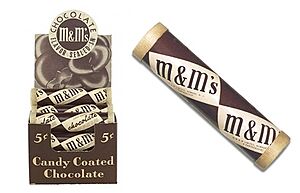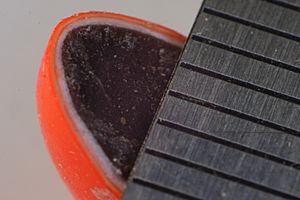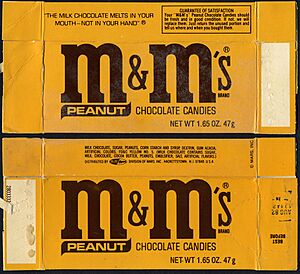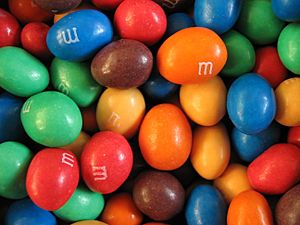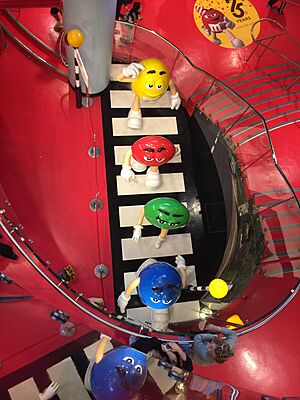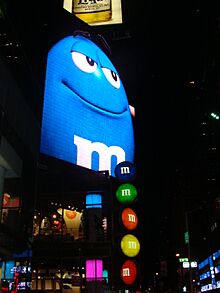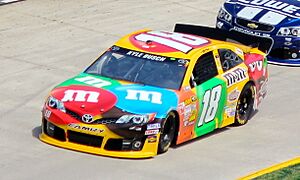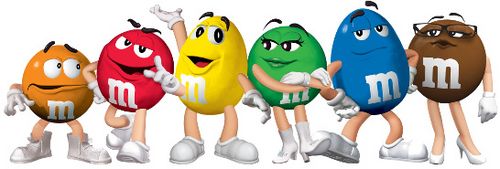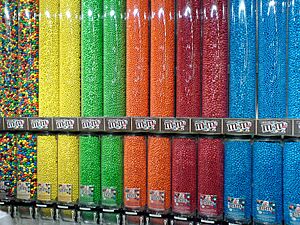- This page was last modified on 17 October 2025, at 10:18. Suggest an edit.
M&M's facts for kids
This page is about the candy. For other uses, see M&M.

Logo used since 2022
|
|
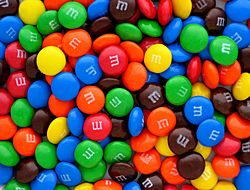 |
|
| Owner | Mars Inc. |
|---|---|
| Country | United States |
| Introduced | September 10, 1941 |
| Related brands | Minstrels, Revels, Treets |
| Markets | Worldwide (more than 100 countries) |
M&M's are popular chocolate candies with a colorful sugar shell. They are made by the Mars Wrigley Confectionery company. Each small candy has a white letter "m" printed on one side. M&M's come in many different colors, and some of these colors have changed over the years.
The first M&M's had a simple chocolate filling. These were later called "plain" M&M's. In 1954, Peanut M&M's were introduced. These have a peanut covered in milk chocolate, then wrapped in a candy shell. Peanut M&M's are still very popular today. Other types include peanut butter, almond, pretzel, crispy, dark chocolate, and caramel M&M's. Some flavors are only available for a short time or in certain places.
M&M's started being made in the United States in 1941. Since 2003, you can find them in over 100 countries around the world. Forrest Mars Sr. created the candy. He might have gotten the idea from a similar candy he saw during the Spanish Civil War. The sugar coating was a great idea because it stopped the chocolate from melting easily in warm weather. This led to their famous slogan: "the milk chocolate that melts in your mouth, not in your hand."
A regular milk chocolate M&M weighs about 0.91 grams. It has about 4.7 calories. Even though M&M's come in many colors, they all taste the same. The color does not change the flavor of the chocolate inside.
Contents
The Story of M&M's
How M&M's Began (1940s–1970s)
In the 1930s, Forrest Mars Sr. saw soldiers eating chocolate candies with a hard shell. These candies were called Smarties and were made in Britain. The hard shell kept the chocolate from melting.
On March 3, 1941, Forrest Mars Sr. received a special permission, called a patent, for his own way of making these candies. He started his candy company, M&M Limited. The "M&M" stands for the last names of Forrest E. Mars Sr. and Bruce Murrie. Bruce Murrie was the son of the president of the Hershey Chocolate Company. Hershey helped Mars get chocolate during a time when chocolate was limited in the USA. M&M's were first made in a factory in Newark, New Jersey.
The first big customer for M&M's was the U.S. Army. Soldiers needed chocolate that wouldn't melt in hot places. During World War II, M&M's were sold only to the military. This made the company grow, and they moved to bigger factories in Newark and later in Hackettstown, New Jersey. Today, M&M's are also made in Cleveland, Tennessee.
In 1949, M&M's introduced their famous slogan: "the milk chocolate that melts in your mouth, not in your hand." In 1950, a black "M" was printed on each candy. This was changed to a white "M" in 1954.
Peanut M&M's were launched in 1954 and were only tan in color. In 1960, yellow, red, and green colors were added to the mix.
In 1976, the color orange was added to M&M's. This happened because red M&M's were stopped for a while due to public health concerns about certain red dyes. Even though M&M's used a different, safer red dye, people were worried about red food colors. Red M&M's were brought back in 1987.
Growing Around the World (1980s)
In the 1980s, M&M's started to be sold in many new countries. These included Australia, Canada, Europe, Japan, and the United Kingdom.
Special M&M's for holidays like Easter and Christmas were launched in 1986. Easter M&M's had bunny, chick, and egg shapes on pastel colors. Christmas M&M's had pine tree, bell, and candle shapes on red and green shells, and some even had a mint flavor. By 1993, these holiday shapes were replaced with the standard "M" logo.
In 1988, almond-centered M&M's, which had been sold briefly in the 1960s, came back for a limited time during Christmas and Easter. They became a regular product in 1992.
New Flavors and Colors (1990s)
In 1991, the Peanut Butter M&M's were released. These candies have peanut butter inside the chocolate shell. In 1995, the tan M&M's were removed and replaced with blue ones. To celebrate the new blue color, there was a special TV show about it.
In the 1990s, M&M's also became popular in Europe, replacing other candies like "Treets" and "Bonitos." In 1996, Mars introduced "M&M's Minis," which are smaller candies sold in plastic tubes. In 1999, Crispy M&M's were released. These were a bit bigger than milk chocolate M&M's and had a crispy wafer center. Crispy M&M's were stopped in the U.S. in 2005 but came back in 2015. They are still available in Europe and Australia.
More Flavors and Re-releases (2000s–Present)
In the 2000s and 2010s, many new M&M's flavors appeared. These included Pretzel (2010), Coffee Nut (2016), Caramel (2017), English Toffee (2019), and Hazelnut Spread (2019).
Mars also launched other M&M's products. A chocolate bar called M-Azing was released in 2004. "Mega" M&M's, which are much larger, came out in 2007 and became a regular product in 2014. M&M's cookies started selling in the U.S. in 2016, and M&M's chocolate blocks were released in Australia in 2017.
In 2020, Fudge Brownie M&M's were released in the United States. They were stopped in April 2024.
On September 28, 2022, a new purple M&M color was announced. They also introduced a new "spokescandy" character named Purple.
How M&M's Are Advertised
M&M's has used clever marketing to become a famous candy brand. They use computer-animated characters, fun stories, and sell many different products. This has made M&M's a well-known candy icon.
In 1982, the Mars company decided not to have M&M's in the movie E.T. the Extra-Terrestrial. Instead, a rival company, Hershey, used their Reese's Pieces candy. When the movie became a huge hit, sales of Reese's Pieces went up a lot, possibly by 300%!
Marketing Campaigns
From 1982 to 1987, the M&M's slogan was "All the World Loves M&M's."
In 1995, M&M's held a "Color Campaign" contest. People voted for a new M&M color: purple, blue, or pink. Blue won with 54% of the votes. The announcement of the new blue color was a big deal, shown on many TV news programs and talk shows. The company even lit the Empire State Building in blue! This campaign brought M&M's a lot of free attention and made more people aware of the brand.
In 1996, Mars made a Christmas TV ad where the Red and Yellow M&M characters meet Santa Claus. This commercial was very popular and has been shown every December since then, making it their longest-running TV ad.
Since "MM" is the Roman numeral for 2000, M&M's were called "The Official Candy of the New Millennium" in 1998. This was also when the "rainbow" variety, with many different fillings, was released.
In 2000, the "Plain" M&M's were renamed "Milk Chocolate" M&M's. Pictures of the colorful candies were added to the traditional brown and white bags.
Team-Up Marketing Campaigns
In 1990, Mars Snackfood US started sponsoring NASCAR races. Many famous drivers have driven cars sponsored by M&M's, including Kyle Busch, who won championships in 2015 and 2019. 2022 was the last year Mars sponsored Kyle Busch.
In April 2005, M&M's had an "mPire" promotion to go along with the Star Wars: Episode III – Revenge of the Sith movie. Dark chocolate M&M's were offered for the first time.
In May 2004, Mars had a Shrek 2 promotion. M&M's were sold as "ogre-sized" (65% larger) and in swamp-ogre colors. In 2005, "Mega" M&M's were added, which were a bit smaller than the ogre-sized ones. Their colors were changed to less bright shades to appeal to older people.
In July 2006, dark chocolate M&M's came back in a purple package. In 2007, dark chocolate peanut M&M's were also released. M&M's became the official chocolate of NASCAR in 2006.
In 2007, M&M's introduced a limited-edition raspberry flavor called "M&M's Razzberry Chocolate Candies."
Also in 2007, the company made a 50-foot tall, smiling Lady Liberty M&M statue. This was to start a campaign where Americans could create their own M&M characters online.
In 2008, two limited-edition flavors were introduced: "Wildly Cherry" and "Mint Crisp" (to go with the Indiana Jones and the Kingdom of the Crystal Skull movie).
They also launched "M&M's Premiums" in 2008. These came in flavors like chocolate almond and mint chocolate. They didn't have a hard candy shell like regular M&M's.
During summer 2008, the company launched "Faces." This allowed customers to print pictures of loved ones on chocolate candies through their website.
In summer 2009, a limited-edition "Strawberried Peanut Butter" flavor was released for the Transformers: Revenge of the Fallen movie. At the same time, a "Coconut" variety was launched and became a permanent item in 2010.
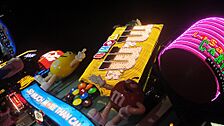
M&M's World store on the Las Vegas Strip.
In April 2010, M&M's launched a new Pretzel variety. In November 2011, Mars released a limited Christmas variety called M&M's Cinnamon Milk Chocolate.
In 2012, two new dark chocolate flavors, Raspberry and Mint, were released. A white chocolate flavor was also released for Easter that year.
Since 1988, special red, white, and blue "Presidential M&M's" have been given as gifts to guests of U.S. presidents. The box has the presidential seal and the president's signature.
M&M's World stores are special shops found in places like Las Vegas, Orlando, New York, London, and Shanghai.
Several video games based on M&M's have also been made.
M&M's Characters
In 1954, early M&M's ads showed two talking M&M characters, one plain and one peanut, diving into a chocolate pool.
In 1995, M&M's introduced a new set of computer-animated "spokescandies" in their TV commercials. These characters were designed to be more grown-up than most food mascots. They include:
- Red: He is often cynical and sarcastic. He is the mascot for milk chocolate, peanut butter, and crispy M&M's.
- Yellow: He is happy and a bit silly. He is the mascot for Peanut M&M's.
- Blue: He is known as the "cool one" and is the mascot for Almond M&M's.
- Green: She is seen as charming. She is the mascot for Dark Chocolate Mint and Peanut Butter M&M's.
- Orange: He is a bit nervous. He was introduced with the Crispy variety and is now the mascot for Pretzel M&M's. He is often joined by Pretzel Guy, who gives him advice.
Other characters that were used but are no longer seen include Chocolate Bar, who always melts, and the Swarmees for the Minis candies.
Female M&M mascots were introduced in 1995. Green was the only female M&M mascot until 2012, when Ms. Brown was introduced. Ms. Brown is known as the "Chief Chocolate Officer."
In January 2022, Mars announced they would change the look of the M&M characters. The goal was to make them represent more different types of personalities. For example, Green and Brown, who are female characters, started wearing more casual clothes. In September 2022, a new Purple M&M was introduced. She first appeared in a commercial singing "I'm Just Gonna Be Me."
In January 2023, the company joked that the M&M characters were taking a break and would be replaced by comedian Maya Rudolph. She even pretended to launch her own candy called "Ma&Ya's" candy-coated clams. But after the Super Bowl game, M&M's confirmed that the spokescandies were back!
| Character | Type | Voice actor |
|---|---|---|
| Red | Milk Chocolate, Dark Chocolate, Peanut Butter, and Crispy |
|
| Yellow | Peanut and Dark Chocolate Peanut |
|
| Blue | Almond, Raspberry, Dark Chocolate, and Hazelnut Spread |
|
| Green | Dark Chocolate, Mint, and Peanut Butter |
|
| Orange (Crispy) | Crispy and Pretzel |
|
| Ms. Brown | Dark Chocolate, Milk Chocolate, and Fudge Brownie | |
| Purple | Peanut, Caramel, Cold Brew, Vegan, and Hazelnut Spread | |
| Caramel (cube) | Caramel | |
| Pretzel Guy (symmetrical) | Pretzel |
M&M's Color Changes Over Time
The first M&M's in 1941 came in red, yellow, purple, green, and brown. Purple was later removed and replaced with tan in the late 1940s.
In 1976, Mars stopped making red M&M's for a while because of health concerns about a certain red dye. They introduced the orange color instead. Even though M&M's didn't use the dye that caused concern, Mars wanted to make sure customers felt safe. Ten years later, a student started a fun campaign to bring back red M&M's, and it became very popular. Red M&M's were brought back, and orange M&M's stayed.
In early 1995, Mars held a contest asking people to vote for a new color: blue, pink, or purple. Blue won with 54% of the votes. Ads for the new blue M&M's showed the characters trying to turn blue. Tan M&M's were replaced by blue ones in late 1995.
In 2002, Mars asked people to vote again for a new color: aqua, pink, or purple. Purple won and was available for a limited time. Special bags of all-purple M&M's were released, and finding one could win you a big prize!
Since 2004, you can order M&M's online in 17 different colors. You can even print personalized messages on one side of the candy. These custom M&M's were first for holidays but are now available all year.
For Valentine's Day in 2008, Mars released bags of only green M&M's. This was because of a fun old story that says green M&M's are lucky. Green M&M's came back for Valentine's Day in 2009.
In October 2011, Mars released M&M's White Chocolate Candy Corn just for Halloween in the United States. These candies came in white, bright yellow, and bright orange colors, like candy corn.
The chart below shows how the colors of the original milk chocolate M&M's have changed over time. From 1941 to 1969, each bag had five colors. When red M&M's came back in 1987, they were added as a sixth color.

See also
 In Spanish: M&M's para niños
In Spanish: M&M's para niños

